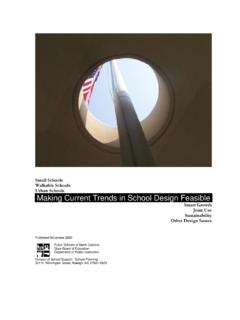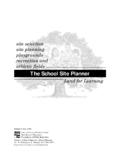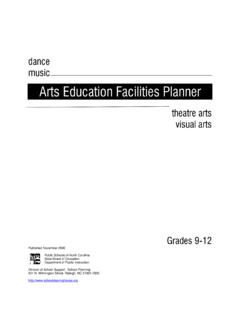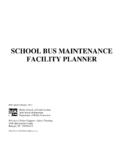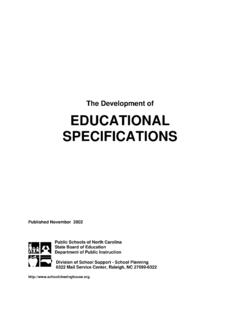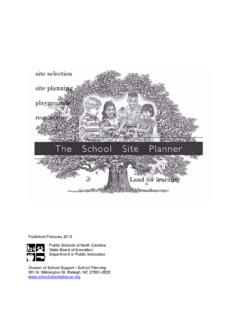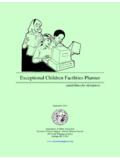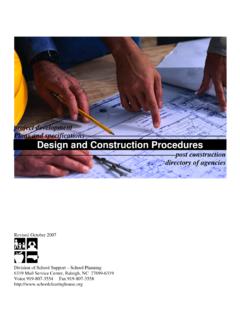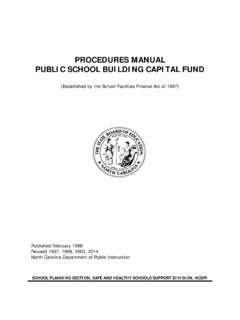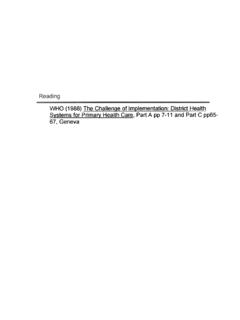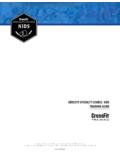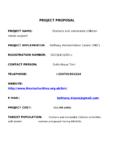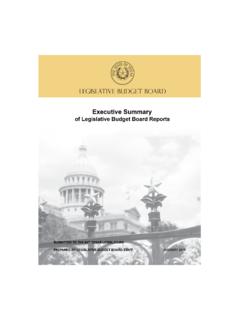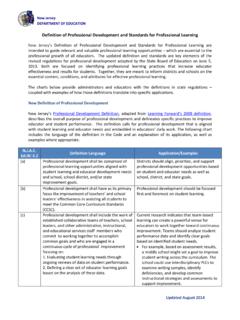Transcription of North Carolina Public Schools - schoolclearinghouse.org
1 Public Schools of North Carolina State Board of Education Department of Public Instruction Public Schools of North Carolina Facilities Guidelines Revised September 2014 In compliance with federal law, including the provisions of Title IX of the Education Amendments of 1972, NC Department of Public Instruction administers all state-operated educational programs, employment activities and admissions without discrimination because of race, religion, national or ethnic origin, color, age, military service, disability, or gender, except where exemption is appropriate and allowed by law. Foreword The responsibility for providing Public school facilities in North Carolina rests with the counties and the special chartered school districts within them.
2 State support for school construction has been provided through state bond issues in 1949, 1953, 1963, 1973, and 1996 when it became apparent that local resources could not keep pace with growing facility needs. In 1987 the Public school Building Capital Fund was created to use a portion of Corporate Income Tax revenue for school construction. Additional State support for school construction has been provided through the NC Education Lottery established in 2005. Local boards of education, which are the legal owners of school facilities, are responsible for planning and erecting appropriate facilities to support instructional programs. The Finance Act of 1987 established the North Carolina Public school Facilities Standards.
3 In August, 1996 the North Carolina General Assembly enacted legislation which directed that these facility standards become facility guidelines. It further directed the State Board of Education to appoint the Public school Facilities Task Force to review and make recommendations for revision of the guidelines, which define and describe minimum facilities to ensure educational program appropriateness and long-term cost efficiency. The Task Force comprised educators, facilities management professionals, design and engineering professionals, and representatives of the North Carolina County Commissioners and school Boards associations and the State Treasurer s office.
4 This publication, originally approved by the State Board in January, 1997 reflects the conclusions of the Task Force. The Public Schools of North Carolina Facilities Guidelines has been developed to provide school systems and designers with useful and reliable design information to use as a basis for new Schools , additions and renovations. We believe that these guidelines will enhance the ability of local school systems to plan effective and efficient facilities which maximize instructional opportunities for students. It is our hope that these guidelines provide strong direction for school design, while maintaining local control of that process. William W. Cobey, Jr., Chairman June St.
5 Clair Atkinson, State Superintendent State Board of Education NC Department of Public Instruction NOTE: Items shown in underline indicate revisions in this edition. Facility Guidelines (September 2014) ii Table of Contents Purpose .. v Long-Range Planning .. 1 school Sites .. 3 Regular Classrooms .. 5 Science .. 8 Small-Group Resource Rooms .. 10 Exceptional Children .. 11 Arts Education Music .. 13 Arts Education Visual Arts .. 15 Arts Education Theater Arts .. 16 Arts Education Theater Arts Auditoriums .. 17 Arts Education Dance .. 19 Career and Technical Education .. 20 Media Centers .. 23 Technology Infrastructure .. 26 Physical Education .. 27 Administration .. 29 Student Support Areas.
6 30 Staff Support 31 Commons, Circulation and Entries .. 33 Child Nutrition Cafeterias .. 35 Building Support Areas .. 38 Modular Units and Modular Buildings .. 39 Fieldhouse, Concession and Other Smaller Construction Projects .. 41 Facility Guidelines (September 2014) iii Table of Contents Outdoor Bleachers .. 43 Designing Safer Schools .. 45 High Performance Buildings .. 48 Plumbing .. 49 Heating, Ventilating and Air Conditioning .. 52 Electrical and Lighting .. 56 Appendix: General Statute 115C-521. Erection of school Buildings .. 60 Feasibility and Cost Analysis, as Required by GS 115C-521 .. 62 Class Sizes and Teacher Allotments .. 63 Stairwell Sign for Multi-Story Elementary Schools .
7 65 Design Information .. 66 Deviation from the North Carolina Public school Facilities Guidelines .. 67 Deviation from the North Carolina Public school Facilities Guidelines Form .. 68 Recommended Lighting Systems, with Illumination Levels .. 69 Projects Reviewed & Not Reviewed by school Planning .. 71 Project Review Transmittal Form .. 72 Definitions and Abbreviations .. 74 Facility Guidelines (September 2014) iv Purpose In July, 1987 the North Carolina General Assembly enacted legislation to provide funds for Public school construction to assist county governments in meeting their capital building needs and to provide additional funds for selected counties with the greatest critical school facility needs.
8 The legislation follows the state s Basic Education Program, which assures every child in North Carolina a program of instruction which is fundamentally complete and which will provide a thorough grounding in .. the arts, communication, media and computer skills, second languages, healthful living, mathematics, science, social studies and vocational education. This document, in accordance with the legislation s direction, defines and describes the educational spaces needed to support a modern, comprehensive educational program and to set minimal guidelines for types of spaces and for sizes of spaces. Consequently, it serves as a planning guide for those in the process of building, enlarging, or renovating school facilities.
9 Administrators, teachers, lay persons and design professionals will find the document helpful as they plan and design educational spaces. The document is also intended: (1) to serve as a guide in evaluating existing facilities for functional adequacy; (2) to determine facility needs; and (3) to develop sound, long-range building plans. Consequently, it includes guidelines and recommendations for improving facilities. The guidelines set forth in this document do not supersede or take precedence over existing laws and codes defined and enforced by other agencies. All plans for new construction and renovations must have approval and specific permits from the appropriate state and local agencies. These reviews, permits and approvals are issued by agencies which include the following, or local jurisdictions with delegated authority: State Dept.
10 Of Insurance/ Office of State Fire Marshal Compliance with the State Building Code NC Department of Health and Human Services Approval of kitchen sanitation NC Department of Environment and Natural Resources: Approval for new on-site water systems Approval of on-site waste water Approval of soil sedimentation and erosion control plans, where one acre or more is to be disturbed. Larger municipalities the local authority may have jurisdictional approval rights. US Army Corps of Engineers Approval of wetlands development (contact DENR first). State Department of Agriculture Approval of propane gas installations. State Board of Education (see Appendix) NC Department of Transportation Driveway approval. The North Carolina school Facilities Guidelines are recommended minimums and should not be construed as averages or as standards, except where noted for science rooms.
